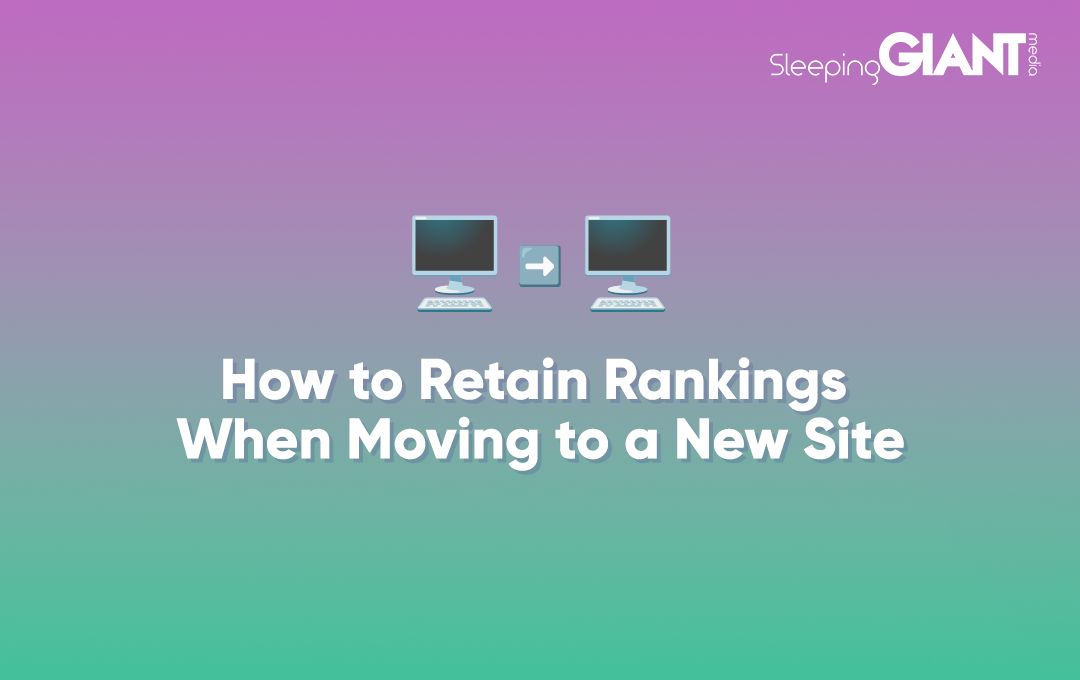
How to Retain Rankings When Moving to a New Site
Moving your business or brand to a new website can be a difficult endeavour to say the least. When it comes to site migrations, there’s a lot at stake and also a lot that can go wrong in the absence of the right skills, patience, and know-how.
But one of the most important things you want to go right is retaining rankings even after your site has moved. If you’re changing location (albeit digitally), you want the audience you’ve spent time and energy curating and maintaining to come with you, right?
In this blog, our team of SEO experts have put their heads together to come up with some guidance for one of every site migration’s biggest challenges: preventing that dreaded drop in performance post-migration.
Read on to get started.
What are the risks associated with site migration?
Before we cover exactly how we can prevent a reduction in rankings, let’s familiarise ourselves with what else is at stake during a site migration. If you fail to consider SEO at every stage of your website migration, you could experience any of the following issues:
- Significant loss of traffic from organic search
- Significant loss of revenue from organic search
- Pages no longer ranking for keywords that used to drive traffic to your site
- Loss of brand visibility in search engines on important keywords
- Important pages no longer being indexed by Google.
That being said, although keeping rankings high post-move is important, try not to intensely focus on this metric without considering the other factors (such as organic traffic, brand visibility, and indexing) that feed into it proportionally.
Why can site migration impact your performance?
Now, let’s explain why upgrading your site may cause harm to your rankings and organic performance. Brands and businesses may want to make changes to their site for any one of the following reasons:
If they are redesigning and rebuilding their website and plan to make significant changes to elements such as URLs, page content, website navigation, and user experience
If there is a domain change. EG: a business is rebranding and needs to change the whole domain name
If they are re-platforming (moving to a different CMS) or upgrading to a newer version of their existing CMS.
But, regardless of why a migration is happening, changing a site means that Google may have to get to know your site all over again, in the meantime dropping your positions until it knows that site is still of value to its users. And what makes Google tick? Trust.
Although there are many factors that determine your search engine position in Google, they all really come down to trust. The more Google trusts your site, the higher they will rank you. You see, Google likes big, old, frequently-updated sites, as it has a history with these sites and almost builds a relationship with them.
So, even if you are moving or changing sites, don’t break trust with Google. In other words, don’t let those core signals of authority and trustworthiness get lost in the move. In order to do this, a successful site migration should, as a bare minimum:
Preserve the SEO value that the old site had built up
Set the site up for organic traffic growth and performance
And future-proof the website for future SEO updates.
Let’s dive into how you can maintain Google’s trust (retaining your rankings) while switching to a shiny new site below.
How to ace your site migration
The steps below should guide you through the migration process and reduce the risk of things going wrong, keeping your performance and rankings right where they were before you moved.
1. Preserve existing content and its SEO value
When launching a new site, it can be tempting to completely start from scratch and rewrite all of the content. But this can be a big mistake as, among that content on the site, you will have valuable assets. By removing this content and starting from scratch you may remove keywords that were included in the content (and performing well) or change the intent of the piece of content, meaning it no longer performs as well for SEO. Often there are some really strong pieces of content already on your site — and these may be driving a large amount of organic traffic too.
Similarly, wanting to make the site “much more visual” by removing a lot of the content can be a red flag. Websites need enough written content to demonstrate authority on your topic, and compromising this for design can harm your SEO efforts.
Determine the value of your existing content
Use existing data you have in analytics tools and Google Search Console to understand the valuable pieces of content on the site. This means looking at what pages currently drive the majority of your organic traffic. You may want, for example, to assess the pages that have the most sessions or users – but also look at the pages that drive the most conversions and revenue, as these are not always your top traffic pages.
It’s important to consider how your existing content plays a role in the user’s journey across the funnel before you think about how to restructure this or make any decisions about removing certain pages, and using your own site performance data is the best way to understand this.
It’s important to then preserve the most important content you have and, where possible, replicate this on the new site. This includes on-page elements such as page titles, headings, and meta descriptions too, as these all play a role in how well the pages are going to perform for particular keywords – and if you are already ranking well for your target keywords, this is important to maintain.
Backlinks are your friend
At this stage, you should look at the backlinks that point to your site. Backlinks provide what we refer to as “link equity” and authority for the site, and if you have backlinks pointing to a URL that is being removed or changed, you may need to get some of those backlinks updated to point to the new locations.
Key takeaways?
- Don’t hastily rewrite, replace, or remove all existing content.
- Use existing analytics data to understand the SEO value of your content.
- Ensure SEO value is preserved across content and on-page elements.
2. Fix those ongoing issues
Use the migration as an opportunity to fix any larger, ongoing issues.
A new site can be a good opportunity to cost-efficiently roll out larger scale changes (which you may not have been able to progress previously due to lack of budget) as part of an already-budgeted project. This is especially true if you use an external developer and don’t have a retainer with them for ongoing changes, as large changes can sometimes be costly, but if you’re working with a budget for a new site design, some of these elements can usually be factored into that rebuilding process.
For example, some of the issues you could look at fixing during the migration might include:
- Making the navigation more user and SEO-friendly
- Reducing overlap and keyword cannibalisation between lots of similar pages of content
- Improving low-value or poor-quality content. For instance, you might have duplicate pages or low word count, thin content on your site that could be improved
- Making technical changes such as working on page speed, or introducing new features and functionality which may have needed a lot of development time and not been a priority on the old website.
3. Remember those redirects
If you’re relocating, you want to tell your audience where you’re moving to and how to get there, right? You need to tell Google – and your users – that the page they are looking for has moved to a new location using a 301 redirect. 301 redirects mean the page has permanently moved (as opposed to 302 redirects which are only temporary).
When redirecting during a migration, we also mean not just applying 301s randomly, but redirecting either like for like, or the closest possible alternative if not. One of the biggest mistakes you can make in a migration when changing your URLs, beyond forgetting to apply any redirects, is applying blanket redirects to the homepage.
While you may think “it’s OK, I’ve implemented a redirect”, if you have redirected everything by default to a single page like the homepage, Google doesn’t understand how to rank this and therefore the relative value that your old content had built up with traffic and rankings won’t be transferred across. This is also bad for user experience too, so you want to send users to either the same page in its new location or the best alternative page where possible if that page no longer exists in any form.
4. Don’t neglect technical SEO
An often overlooked part of the site migration process is technical SEO and its nuances. A few pointers to remember on this:
– If you’re adding new images to the site as part of the redesign, ensure these are optimised to not impact the page speed.
– Check for basics like noindex tags and canonical tags to ensure these are applied correctly.
Site map submission
Once the new or amended site is live, make sure that you resubmit or submit a new and improved site map. By submitting this site, Google is able to better pick up all the new URLs that you have created — meaning that you may start ranking quicker with the new site.
Tracking codes
One other area that can be forgotten about in a site migration is tracking. While tracking obviously doesn’t impact SEO performance directly, if tracking codes are missing or broken when you launch the new site, it can really impact your ability to measure performance post-migration, and this makes it harder to assess whether the migration has gone well or not.
If tracking is missed during the migration process, you could find yourself in a position where you are not tracking visits to your new site at all, or that you’re not measuring things the same as they were before on the old website.
The most basic issue we tend to see during a migration gone wrong is tracking codes that have been forgotten about entirely, but another really common one is conversion points changing during the launch. For example, because forms have been changed in the redesign, which may mean your conversion or event tracking in GA4 or other platforms no longer fires as it should.
5. Make a post-migration SEO strategy
A common trap that people can fall into with SEO is assuming that if you’ve done the optimisation once, you don’t need to touch it again. Unfortunately with SEO that’s not the case, as things are changing in the industry all the time.
Follow the guidance below to roll out a long-term strategy to future proof your migration:
- Think about your goals and KPIs and how you can use SEO to help you achieve them.
- Work with your marketing and SEO team members, or your external partners to develop a strategy that considers content growth as well as upcoming innovations in the industry.
Putting that all together should stand you in good stead to retain your rankings even if you move site.
Want plain sailing with your site migration?
With over 15 years of experience in digital marketing, our Giants are best placed to help you navigate the choppy waters of site migration and turn things into plain sailing. Our passionate SEO team is on hand to answer any questions you may have while guiding you through the process, working alongside your developers and in-house teams.
Get in touch with us today to see how we can help. Or, for more technical SEO advice, keep up to date with our blog.
Blog
How to Grow Your Digital Prestige With Social Media
Louis Vuitton currently reigns supreme among the luxury goods brands on social...
Giant Wednesday
How To Optimise Images For Websites
Digital Marketing, technology & business insights, how-to's and explainer...
Follow Us
Sign Up For More
Stay up to date with the latest happenings, learnings, events & more with our GIANT Newsletters.
Contact Us
Top Floor, The Civic Centre, Castle Hill Avenue, Folkestone CT20 2QY.




